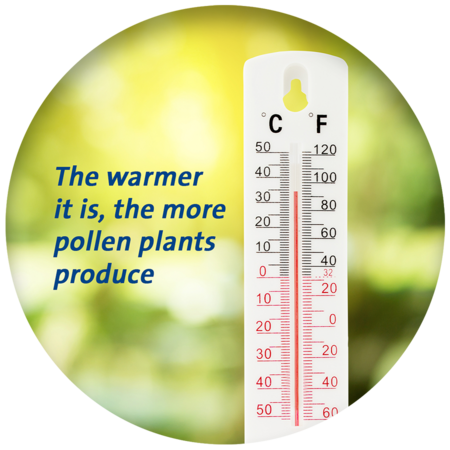Coming soon: the 52-week allergy season?
There are two reasons for this: the warm weather gets people outdoors and plants increase pollen production as the temperature rises.
Using data from over 60 measuring stations, a team of researchers from Canada and the USA has discovered that the time that pollen is in the air, and with it the hay fever season, has increased by almost a month over the last 30 years. On average, it starts about 20 days earlier and ends just under ten days later.
Temperatures are rising the world over and the North American data reveals a global trend with regional variations. This is bad news for people who suffer from allergies because their close season is getting shorter and shorter, while the air fills with more and more pollen. Increasing numbers of people are reacting to the pollen count and many of their reactions are more severe.

the warmer it is, the more pollen plants produce. Stress caused by heat or water scarcity during droughts further increases the amount of pollen in the air as plants try to boost reproduction and ensure the survival of their species. Climate change has also caused the flowering time of many plants to shift forward. The amounts of airborne pollen typical of the hay fever season can now be found in the very first months of the year.
In a warm autumn, grasses in temperate latitudes can continue to flower well into October. People who are allergic to several types of pollen hardly have time to breathe.
The typical symptoms of hay fever include sneezing attacks, rhinitis, swollen eyelids, itchy eyes, and fatigue. Here’s how it works: pollen triggers an immune reaction, so the body releases histamine to fight it, causing inflammation. Although medication is available to alleviate symptoms, it is rarely possible to experience everyday life free of symptoms. Only a low-pollen environment offers lasting relief. Such an environment can be provided using air purifiers and ventilation systems in buildings or cabin air filters in cars, buses, and trains.
Minimizing airborne allergens is especially important because those affected are also more susceptible to bacterial and viral infections. The fact that your immune system is already running at full steam during the pollen season makes it easier for pathogens to multiply. Another problem is that an untreated pollen allergy increases the risk of developing asthma.
Quellen:
https://www.nifa.usda.gov/about-nifa/impacts/yes-allergy-seasons-are-getting-worse-blame-climate-change
https://www.cdc.gov/climateandhealth/effects/allergen.htm
https://www.ecarf.org/info-portal/allergien/pollenallergie/
https://www.swr.de/wissen/klimawandel-pollenflug-allergiker-probleme-frueher-andere-pflanzenarten-100.html
https://www.pollenwarndienst.at/aktuelle-belastung/belastungskarte-europa.html